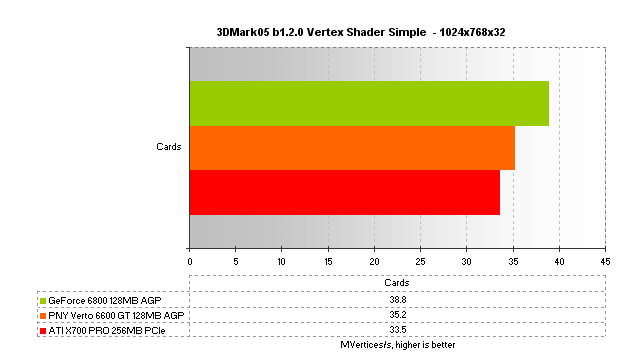Fillrate and shading
Let's take a look at the cards' basic vital statistics.| Card | PNY Verto 6600 GT | NVIDIA GeForce 6800 | ATI RADEON X700 PRO |
| Interface/speed | AGP/8x | AGP/8x | PCI-Express x16 | Onboard memory | 128MB | 128MB | 256MB | Core speed | 500MHz | 335MHz | 420MHz | Rendering pipelines | 8 | 12 | 8 | Fillrate (multi-texture) | 4GTexels/s | 4.02GTexels/s | 3.36GTexels/s | Memory interface | 128-bit | 256-bit | 128-bit | Memory speed | 900MHz | 700MHz | 864MHz | Memory bandwidth (max) | 14.4GB/s | 22.4GB/s | 13.8GB/s |
How do theoretical figures compare with 3DMark05's synthetic's?.


Multi-texturing fillrates are all very close, if not on, the theoretical limit of each card. Single-texturing fillrate can't quite match that of the 6800's. The reason lies with the 6600 GT's architecture, which has 8 rendering pipelines but only 4 raster operations. What that means in plain English, is that in a traditional model featuring an equal number of rendering pipelines and ROPs, not all ROPs are used to full capacity all the time. Having only 4, in the case of the 6600 GT, and an intelligent switch between rendering pipelines and ROPs, one can still achieve decent multi-texturing performance without having the additional cost and die space associated with 8 ROPs. Keep 'em busy. Single-texturing performance suffers, as the graph shows, but most games use multi-texturing, anyway.

In terms of Pixel Shading, the PNY Verto 6600 GT is right in the middle of the other two cards.


Here's where the RADEON X700 6 Vertex Shaders, coupled with the reasonable core speed, show their worth. 6600 GT has only 3 (although the shading ability of each company's shader is different) and the 6800-series has 6. That's why the 6800 card, even though it's clocked far lower than the 500MHz-rated 6600 GT, shades better in the 3DMark05 Complex test. Of course, testing at 1024x768 doesn't reflect how cards will perform once the image resolution and ante are stepped up. Also, these theoretical tests don't really account for the performance impact of the extra 128MB of onboard RAM on the X700 PRO card.









